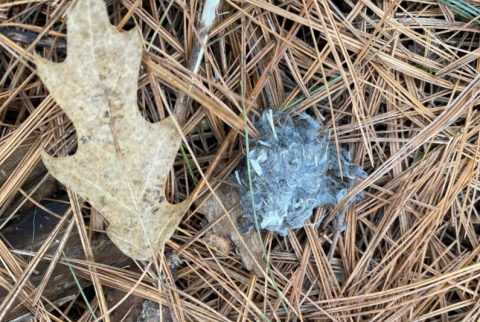
Owl Pellets Reveal Unique Eating Processes and Behaviors
Shown is an owl pellet, which when broken apart, will reveal types of creatures eaten by the owl. Owls create pellets in their digestive system that consist of the indigestible parts of what they ingest: bones, fur, feathers. These pellets are regurgitated and may be discovered by curious explorers. Owls offer a great opportunity to study about animal adaptations that allow survival and growth including:
- Anatomy (large head, face mask, fixed-forward-oriented eyes that allow owl head to rotate 270 degrees, some species have their ear openings different heights on the skull for auditory acuity)
- Feather structure (soft, voluminous, flexible and outer edges are fibriate~to mute sounds; unique face feathers funnel light and sound).
- Hunting techniques (nocturnal or crepuscular hunter with almost soundless flight, prey not caught in flight
- Digestion (no crop so food is digested in the gizzard, gizzard has low acid level so bones, hair, feathers are not digested, indigestible parts passed to proventriculus until rolled into a bolus and regurgitated)
Location
Waterloo, Iowa
Driving Question
- How is such an unusual object (owl pellet) created from a living creature?
Probing Questions
- How do these unique forms and functions contribute to owl growth and survival?
Classroom Suggestions
Students could:
- Dissect an owl pellet and identify the animals the owl had ate.
- Explore the digestive system of an owl and how pellets are created.
Resources
- World of Owls | Food and Hunting: Describes the digestive system of owls, comparing it to other birds and describes pellets.
- Audubon | What is An Owl Pellet?: Information about owl pellets including photo of owl in action.
- Cornell Lab | An Owl Pellet Investigation: Cornell Lab info and activity for teachers.
- Cornell Lab | Bone ID Chart: Downloadable chart and an opportunity to sign up for free teacher newsletter.
Iowa Core Alignment
4-LS1-1:Construct an argument that plants and animals have internal and external structures that function to support survival, growth, behavior, and reproduction
Credit Info
Submitted by Stacey Snyder.
Funding for Iowa Science Phenomena provided by:




